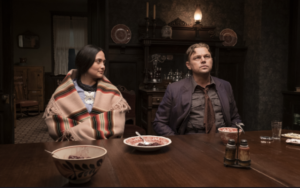KILLERS OF THE FLOWER MOON: 4 STARS. “classically made, slow burn of a crime story.”
 Greed and murder are not new themes in the work of Martin Scorsese, but the effects of those capital sins have never been more darkly devastating than they are in “Killers of the Flower Moon.”
Greed and murder are not new themes in the work of Martin Scorsese, but the effects of those capital sins have never been more darkly devastating than they are in “Killers of the Flower Moon.”
A study in the banality of evil, the story, loosely based on David Grann’s 2017 nonfiction book of the same name, is set in 1920s Oklahoma, a time of an oil rush on land owned by the Osage Nation. The discovery of black gold made the Indigenous Nation the richest people per capita on Earth. With wealth came an influx of white interlopers, “like buzzards circling our people.”
Among them is William King Hale (Robert De Niro), a seemingly respectable Osage County power broker. He speaks the area’s Indigenous language and publicly supports the Osage community, but, as we find out, it is his insidious and deadly dealings with his Indigenous Osage neighbors that filled his bank account. “Call me King,” he says unironically.
When his nephew and World War I vet Ernest Burkhart (Leonardo DiCaprio) arrives, looking to start a new life, Hale brings him into a years long con to defraud the Osage people through marriage scams and murder by setting up a connection between Mollie (Lily Gladstone), a wealthy Osage woman, and Ernest.
“He’s not that smart,” says Mollie, “but he’s handsome. He looks like a coyote. Those blue eyes.”
Mollie sees through the overture, noting, “Coyote wants money,” during their first dinner, but despite the economic angle, the pair marry, making Ernest an heir to her fortune if something should happen to her.
That economic element lays at the dark heart of Hale’s plan. He orchestrates matches between the monied Osage mothers, sisters and daughters with carefully chosen white men, who exploit them, murder them, and siphon off the oil money from their estates.
This reign of terror claims the lives of more than two dozen Osage women, attracting the attention of the newly formed Bureau of Investigation agent Tom White (Jesse Plemons) and his crew.
The murderous real-life scheme behind “Killers of the Flower Moon” is the most depraved crime and villain Scorsese has ever essayed on film.
The wholesale murder for money is driven not just by greed, but also by white supremacy, oppression of culture and a diabolical disregard for human life. It is pure evil, manipulated by Hale, played by De Niro as the smiling face of doom.
De Niro has played dastardly characters before, but he’s never been this vile. And this is an actor who played The Devil in “Angel Heart.”
The thing that makes Hale truly treacherous and morally irredeemable is the way he insinuates himself into the lives of the very people he was exploiting and having murdered. He is a master manipulator, who will shake his victim’s hand while using his other hand to stab them in the back, and De Niro’s embodiment of him is skin crawling. “This wealth should come to us,” he says, “Their time is over. It’s just going to be another tragedy.”
As Ernest, DiCaprio goes along with the plan, but, unlike his uncle, has a hint of a conscience even as he does horrible things. He’s a weak person, torn between love for his wife and his uncle’s plan to eliminate her and her family.
The center of the story is Mollie, played with quiet grace by Gladstone. Although she disappears from the screen for long periods of time, it is her presence that provides the film with much needed heart and soul. She is strong in the face of illness and betrayal, but her stoicism portrays a complexity of emotion as her family members are murdered and her own life is endangered. Mollie is as spiritual as Hale is immoral, and that balance is the film’s underpinning.
“Killers of the Flower Moon” earns its three-and-a-half hour runtime with a classically made, multiple perspective, slow burn of a crime story that sheds light on, and condemns, the brutal treatment of Indigenous people.
